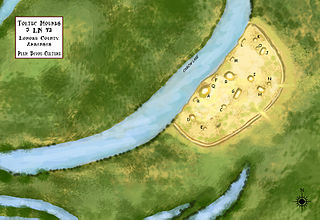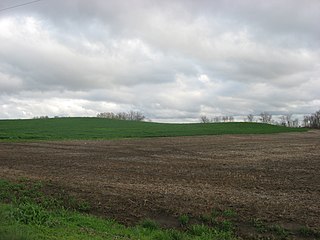
Shiloh Indian Mounds Site (40HR7) is an archaeological site of the South Appalachian Mississippian culture. It is located beside the Tennessee River on the grounds of the Shiloh National Military Park, in Hardin County of southwestern Tennessee. A National Historic Landmark, it is one of the largest Woodland era sites in the southeastern United States.
This is a list of the more than 2,000 properties and historic districts in the U.S. state of Georgia that are listed on the National Register of Historic Places. Listings are distributed across all of Georgia's 159 counties. Listings for the city of Atlanta are primarily in Fulton County's list but spill over into DeKalb County's list.

This is a list of properties and districts in Illinois that are on the National Register of Historic Places. There are over 1,900 in total. Of these, 85 are National Historic Landmarks. There are listings in all of the state's 102 counties.
This National Park Service list is complete through NPS recent listings posted July 28, 2023.

The Kolomoki Mounds is one of the largest and earliest Woodland period earthwork mound complexes in the Southeastern United States and is the largest in Georgia. Constructed from 350CE to 600CE, the mound complex is located in southwest Georgia, in present-day Early County near the Chattahoochee River.
The Mound House is an archeological site located in Greene County, Illinois in the Illinois River floodplain. The site is a multicomponent site; however, the mounds were constructed during the Middle Woodland and are associated with the Havana Hopewell culture. The mound center has two identified mounds.

Plum Bayou Mounds Archeological State Park, formerly known as "Toltec Mounds Archeological State Park", also known as Knapp Mounds, Toltec Mounds or Toltec Mounds site, is an archaeological site from the Late Woodland period in Arkansas that protects an 18-mound complex with the tallest surviving prehistoric mounds in Arkansas. The site is on the banks of Mound Lake, an oxbow lake of the Arkansas River. It was occupied by its original inhabitants from the 7th to the 11th century. The site is designated as a National Historic Landmark.
This is a list of the National Register of Historic Places entries in Columbus, Ohio, United States. The National Register is a federal register for buildings, structures, and sites of historic significance. This is intended to be a complete list of the properties and districts in Columbus.
Janet's Mound, also known as site 22-Ch-520, is an archeological site in the general area of French Camp, Mississippi. Its specific location is not disclosed, but the site is more significant for its location in an area of the state which has few mounds and where little archeological research of mounds has been conducted.

Caddo Mounds State Historic Site (41CE19) is an archaeological site in Weeping Mary, Texas. This Caddoan Mississippian culture site is composed of a village and ceremonial center that features two earthwork platform mounds and one burial mound. Located on an ancient Native American trail later named by the Spanish as El Camino Real de los Tejas, the settlement developed hundreds of years before the arrival of Europeans to the region. Archaeologists believe the site was created in approximately 800 CE, with most major construction taking place between 1100 and 1300 CE.
The Hughes Mound Site, (3SA11), is an archeological site in Saline County, Arkansas near Benton. The 4.5-acre (1.8 ha) is an important Caddoan Mississippian culture village center, at the northeastern frontier of that civilization. It is the only known platform mound site south of Benton on the Saline River. The site has not been dated, but artifacts found there are consistent with the Caddoan period; no contact-period artifacts have been found.

The Ware Mounds and Village Site (11U31), also known as the Running Lake Site, located west of Ware, Illinois, is an archaeological site comprising three platform mounds and a 160-acre (65 ha) village site. The site was inhabited by the Late Woodland and Mississippian cultures from c. 800 to c. 1300. The village is one of the only Mississippian villages known to have existed in the Mississippi River valley in Southern Illinois. As the village was located near two major sources of chert, which Mississippian cultures used to make agricultural tools, it was likely a trading center for the mineral.

Boone's Mounds are a ceremonial site of the Coles Creek culture located in Calhoun County, Arkansas. The site is one of the largest mound sites in the Ouachita River valley. Archeological excavation at the site has yielded dates of occupation as early as 600 AD, and it may still have been in use during the early contact period, c. 1700. The site was located on private property at the time of its listing on the National Register of Historic Places in 1980.

Dogtooth Bend Mounds and Village Site is an archaeological site located on the western shore of Lake Milligan in Alexander County, Illinois. The site includes two mounds and a village site stretching northwest of the mounds. The village was inhabited by Middle Mississippian peoples from roughly 900-1600 A.D. It likely served as a trade hub and a social center for residents of the surrounding farmland. Formal archaeological investigation of the site was initiated in 1950 by Irvin Peithman of Southern Illinois University.

The Emerald Mound and Village Site is a pre-Columbian archaeological site located northwest of the junction of Emerald Mound Grange and Midgley Neiss Roads in St. Clair County, Illinois. The site includes five mounds, two of which have been destroyed by modern activity, and the remains of a village. Middle Mississippian peoples inhabited the village, which was a satellite village of Cahokia. The largest of the mounds is a two-tiered structure that stands 50 feet (15 m) high; its square base is 300 feet (91 m) across, while its upper tier is 150 feet (46 m) across. At the time of its discovery, the mound was the second-largest known in Illinois after Monks Mound at Cahokia.

The Horseshoe Lake Mound and Village Site is a pre-Columbian archaeological site located on the northeast shore of Horseshoe Lake in Madison County, Illinois. The site includes a platform temple mound and a village site with the remains of multiple houses. The site was inhabited by Mississippian peoples during the Late Woodland period from roughly 600-1050 A.D. The village at the site was part of the settlement system connected to Cahokia; it was a third line community, a class of community distinguished by a single temple mound, in the system. Of the five known third line communities in the Cahokia system, the Horseshoe Lake Site is the only one which is relatively intact. The site also includes substantial plant and animal remains, which indicate that its settlers produced maize.
Blair Mound is a historic archaeological site located near Winnsboro, Fairfield County, South Carolina. Blair Mound is an earthen mound structure in the form of a low, oval hummock. It measures approximately 75 by 50 yards and is just over 5 feet (1.5 m) high, with evidence of leveling for agricultural development.
The Adamson Mounds Site (38KE11) is an archaeological site located near Camden, Kershaw County, South Carolina. It is a prehistoric Native American village site containing one large platform mound, a smaller mound, possibly a third still smaller mound, and a burial area. It served as a regional ceremonial center. This site represents a widespread, late prehistoric Mississippian culture known by the names of Lamar, Irene, or Pee Dee and dates probably between AD 1400 and AD 1700.

The McCune Mound and Village Site is a prehistoric archaeological site located in Whiteside County, Illinois near the city of Sterling. The site consists of a single mound, 3 metres (9.8 ft) high and 23 metres (75 ft) in diameter, and five depressions that may have been housing sites. The site was occupied by Upper Mississippian peoples from roughly 1200 to 1500 A.D.; it is considered part of the Langford tradition, a subset of Upper Mississippian culture found in northwestern Illinois. Modern archaeologists first documented the site in 1961. As a relatively intact site with a single-component habitation, the site was considered to have the potential to provide significant information on the Langford tradition.
The Four Mounds site is a historic site located in Dubuque, Iowa, United States. It is made up of a row of four conical burial mounds on a blufftop that overlooks the Mississippi River. They are prehistoric in their origin. The site was individually listed on the National Register of Historic Places in 2000. It was included as a contributing property in the Four Mounds Estate Historic District in 2002.
Morrison Mounds is a historic site located north of Battle Lake, Minnesota, United States. It consists of 22 Indian burial mounds that were built beginning in 800 B.C. There are 20 conical mounds, one flat-topped mound, and one elongated mound near Otter Tail Lake. This site has the oldest radiocarbon date for any mound group in the state of Minnesota. However, its construction is similar to other mound groups in the area which suggests they are all from the same social group that built them over a period of time. Similarities include a central burial pit, logs over the burial pit, and the possibility of partial cremation on-site. The site was listed on the National Register of Historic Places in 1973.













